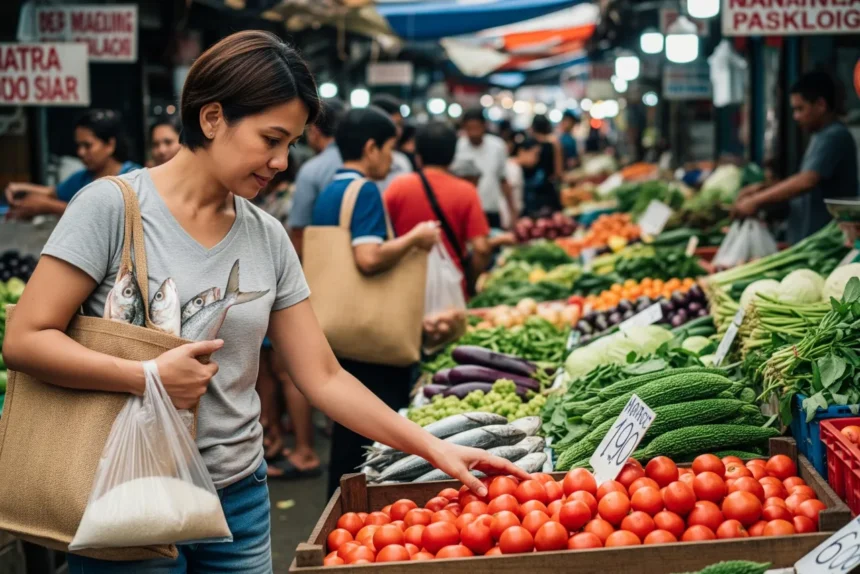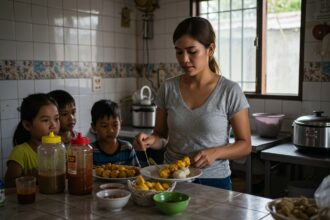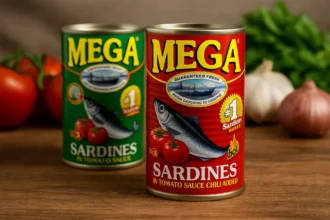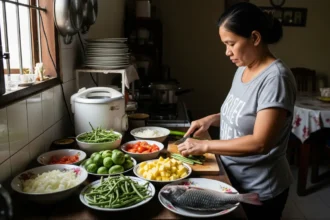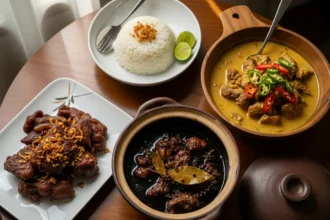Every Filipino family knows the struggle: food prices keep climbing, but salaries don’t always keep up. Whether it’s rice, cooking oil, meat, or vegetables, even the basics seem harder to afford. The question is no longer just about saving a few pesos – it’s about making sure the family eats well despite relentless price hikes.
- 🥦 Prioritize Essentials Over Luxuries
- 🛍 Shop at Wet Markets Instead of Supermarkets
- 📦 Buy in Bulk When Possible
- 🍳 Stretch Meat with Vegetables and Sabaw
- 🥚 Eggs, Tofu, and Dried Fish: Affordable Protein Sources
- 📅 Plan Weekly Menus and Stick to a List
- 📱 Track Expenses and Adjust Midweek
- 💡 Security Measures That Could Protect the Grocery Budget
- ❓ Frequently Asked Questions (FAQ)
- ✨ Final Reflection: Turning Tipid Into a Family Strength
- 🛒 References
Stretching the grocery budget requires strategy, discipline, and creativity. The good news is that Filipino households have long mastered the art of “diskarte” when it comes to food. Here’s a practical guide to making sure your family stays well-fed without breaking the bank.
🥦 Prioritize Essentials Over Luxuries
When prices are high, the first step is to separate wants from needs. Essentials include rice, vegetables, eggs, affordable fish, and cheaper cuts of chicken or pork. Luxuries are branded snacks, sodas, and pre-packaged meals that eat up a huge chunk of the budget without adding much nutrition.
By focusing on nutrient-dense basics, families can cover their food needs while still meeting nutritional requirements. For example, one kilo of rice plus gulay dishes can feed more people than one bag of chips or a few soft drinks. During times of inflation, discipline means sacrificing the less important items to make way for healthier staples.
🛍 Shop at Wet Markets Instead of Supermarkets
Supermarkets may be convenient, but wet markets (palengke) often have lower prices and fresher produce. Vegetables, fruits, and even fish are usually cheaper in the morning market compared to grocery chains.
Aside from lower costs, buying at the palengke also allows haggling, especially if you’re a suki (regular customer). Many vendors give discounts or throw in extra gulay when they know you. Building that relationship can stretch your budget further, compared to fixed supermarket prices.
📦 Buy in Bulk When Possible
Some items become cheaper when purchased in larger quantities. For instance, a 25-kilo sack of rice costs less per kilo than buying retail every few days. The same applies to sugar, cooking oil, and even seasonings like soy sauce or vinegar.
Of course, bulk buying only works if you have proper storage. Investing in airtight containers helps avoid spoilage and waste. Families can also consider pooling money with neighbors or relatives to split bulk purchases, making big savings accessible to more households.
🍳 Stretch Meat with Vegetables and Sabaw
Protein is often the most expensive part of the grocery list. A smart Filipino strategy is to extend meat dishes with gulay or broth. Dishes like nilaga, tinola, or sinigang use smaller cuts of meat but stretch flavor with vegetables and lots of soup.
Another strategy is to use more gulay than meat in stir-fried dishes. For example, a quarter-kilo of pork giniling can serve more people when mixed with potatoes, carrots, and sayote. Not only does this save money, it also makes meals more balanced and healthier.
🥚 Eggs, Tofu, and Dried Fish: Affordable Protein Sources
Instead of always relying on pork or chicken, families can incorporate budget-friendly proteins like eggs, tofu (tokwa), and dried fish (tuyo, daing, dilis). These alternatives are not only cheap but also versatile in Filipino cooking.
Eggs can be boiled, fried, scrambled with gulay, or used for torta dishes. Tofu can replace meat in adobo or stir-fries. Dried fish, when paired with tomatoes and rice, becomes a satisfying ulam for the whole family. By diversifying protein sources, families reduce reliance on costly meats while still enjoying flavorful meals.
📅 Plan Weekly Menus and Stick to a List
Impulse buying is one of the biggest reasons grocery bills go over budget. To avoid this, families should plan weekly menus before heading to the market. With a clear list, it’s easier to resist unnecessary purchases and focus on essentials.
For example, mapping out seven dishes in advance ensures that every ingredient is used efficiently. A bunch of kangkong today can be split between sinigang and adobong kangkong tomorrow. A whole chicken can be divided into tinola, adobo, and fried chicken portions for three separate meals. This level of planning prevents waste and maximizes every peso spent.
📱 Track Expenses and Adjust Midweek
Sometimes the problem isn’t just overspending but not knowing where the money goes. Keeping a small notebook or using a budget-tracking app can help monitor grocery expenses.
By writing down every purchase, families can see patterns – like spending too much on snacks or soda – and make adjustments the following week. Tracking allows you to identify habits that sabotage the budget and gives a clearer picture of where cuts can be made.
💡 Security Measures That Could Protect the Grocery Budget
While you can’t control inflation, you can control how you spend. Here are some practical strategies:
- ✅ Stick to home-cooked meals instead of takeout.
- ✅ Reuse leftovers by turning them into new dishes (e.g., adobo flakes from leftover adobo).
- ✅ Switch to cheaper brands for basic items like sugar, soy sauce, or vinegar.
- ✅ Cook in bulk and store in portions to save on gas and electricity.
- ✅ Grow herbs or small vegetables like kamote tops or pechay in containers.
These small changes build up over time, making grocery money last longer despite price hikes.
❓ Frequently Asked Questions (FAQ)
Q1: Is it really cheaper to cook at home than buy food outside?
Yes. A simple meal cooked at home (like ginisang gulay with rice) can cost as little as ₱20–30 per person, compared to fast food meals that start at ₱100. Home cooking also ensures healthier, cleaner food for the family.
Q2: How do I handle sudden price spikes in rice or meat?
Adjust menus by substituting cheaper alternatives. For example, replace pork with tofu or dried fish for the week, or buy rice in bulk before prices increase further. Flexibility is key to surviving sudden hikes.
Q3: Can meal prepping save money?
Definitely. Cooking larger portions and storing them reduces food waste and saves gas or electricity. Prepping also helps avoid costly last-minute takeout orders.
Q4: Are cheaper brands safe to use?
Most generic or lesser-known brands are safe, especially if they’re BFAD-approved. Many are just repackaged versions of the same products sold at higher prices. Always check packaging labels for quality assurance.
Q5: How can I make meals filling even with smaller portions of meat?
Adding gulay, sabaw, and carbs like rice or sweet potatoes makes meals heavier and more satisfying. Seasonings and sawsawan (sauces) also help enhance flavor without needing large amounts of meat.
Q6: What’s the best way to avoid food spoilage?
Proper storage is essential. Use airtight containers, refrigerate perishables, and avoid buying more than your family can consume in a week. Freezing meats in small portions also prevents waste.
Q7: Can I really save money by planting gulay at home?
Yes, even small gardens can reduce costs. Kamote tops, pechay, and kangkong grow easily in pots and provide free, healthy side dishes to meals.
Q8: How much should I budget weekly for groceries for a family of 4?
This depends on location and lifestyle, but many Filipino families survive on ₱1,500–₱3,000 weekly for groceries by sticking to tipid strategies and prioritizing essentials.
✨ Final Reflection: Turning Tipid Into a Family Strength
Price hikes may feel overwhelming, but Filipino families have always thrived under pressure by finding creative, practical, and loving ways to adapt. Stretching a grocery budget is more than just financial survival – it’s about safeguarding the well-being of the entire household.
By focusing on essentials, making smart choices in where and how to buy, and learning to maximize every ingredient, families can endure inflation without losing the joy of mealtimes. These adjustments may seem small – like switching from pork to eggs, or planting kamote tops in pots – but they add up to real savings and stronger resilience.
Ultimately, a grocery budget is not just about pesos and centavos. It’s about how Filipinos protect dignity, nurture health, and preserve family unity even in difficult times. With discipline and creativity, every meal becomes more than food; it becomes proof of Filipino resilience and love.
🛒 References
-
Metrobank – How to Budget for Grocery and Stick to It
-
ThePeachKitchen – Grocery List for ₱2000: Family Meals & Tips
-
Moneymax PH – 13 Grocery Tips and Tricks to Save Money
-
YouTube – 2K Pesos Budget Grocery Shopping 2025



